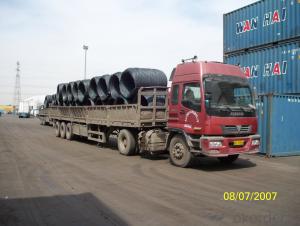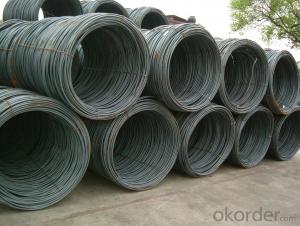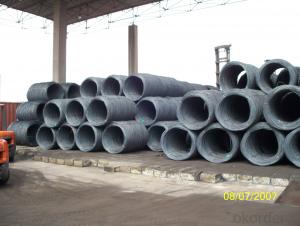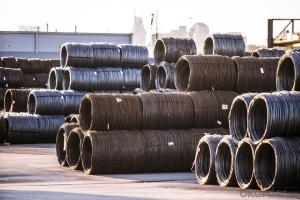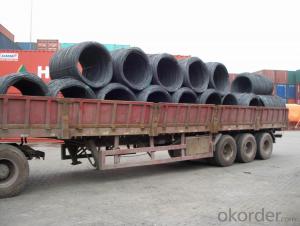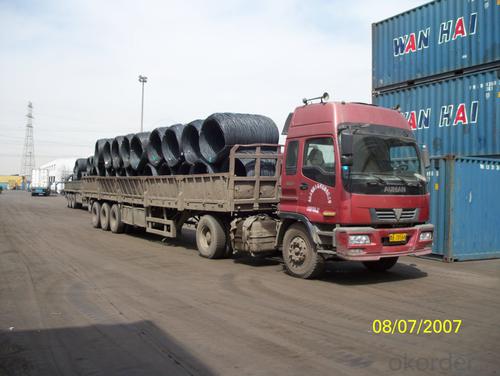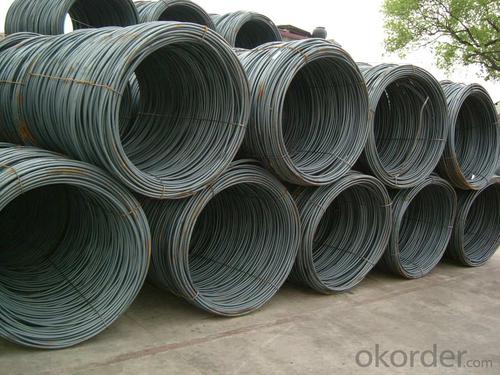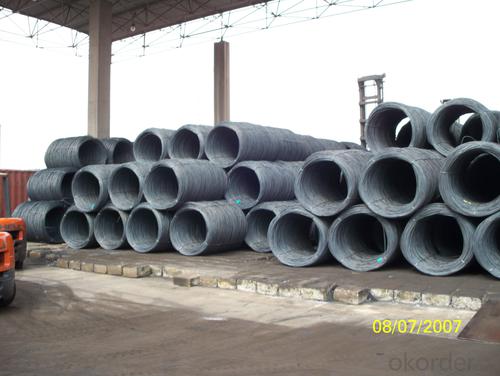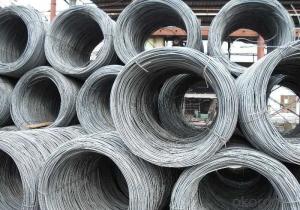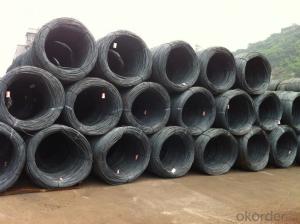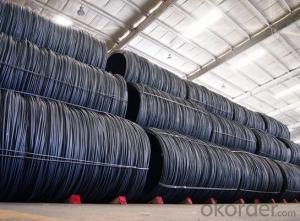SAE1006Cr Carbon Steel Wire Rod 8mm for Welding
- Loading Port:
- Shanghai
- Payment Terms:
- TT OR LC
- Min Order Qty:
- 100 m.t
- Supply Capability:
- 30000 m.t/month
OKorder Service Pledge
OKorder Financial Service
You Might Also Like
Specification
Description of SAE1006Cr Carbon Steel Wire Rod 8mm for Welding:
OKorder is offering Color Coated Steel Coil Prepainted Steel Coil at great prices with worldwide shipping. Our supplier is a world-class manufacturer of steel, with our products utilized the world over. OKorder annually supplies products to European, North American and Asian markets. We provide quotations within 24 hours of receiving an inquiry and guarantee competitive prices.
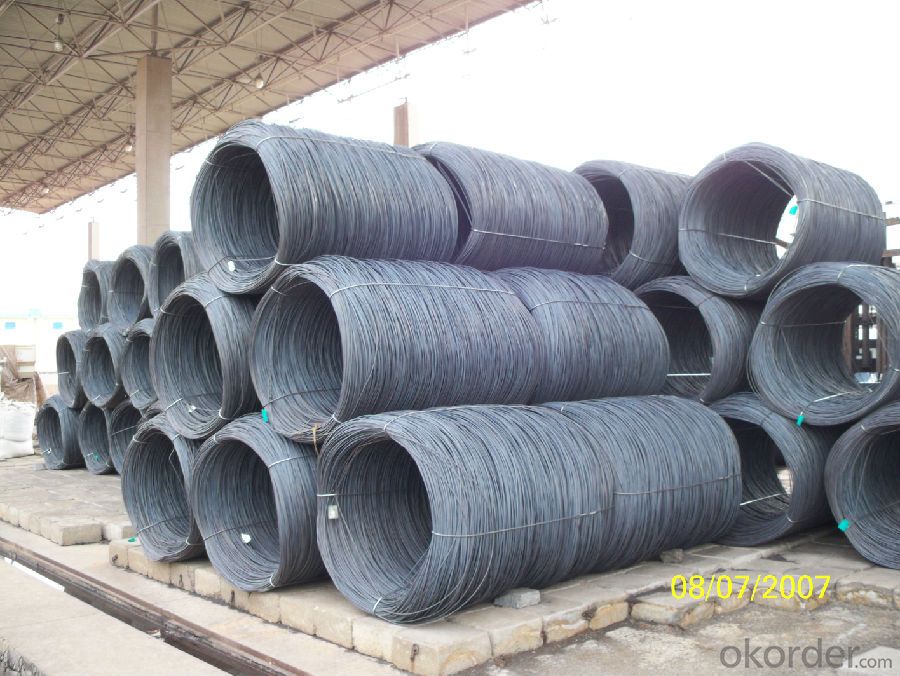
Applications of SAE1006Cr Carbon Steel Wire Rod 8mm for Welding:
Color Coated Steel Coil Prepainted Steel Coil are ideal for structural applications and are widely used in the construction of buildings and bridges, and the manufacturing, petrochemical, and transportation industries.
Main Product Features of SAE1006Cr Carbon Steel Wire Rod 8mm for Welding:
· Premium quality
· Prompt delivery & seaworthy packing (30 days after receiving deposit)
· Corrosion resistance
· Can be recycled and reused
· Mill test certification
· Professional Service
· Competitive pricing
Specifications of SAE1006Cr Carbon Steel Wire Rod 8mm for Welding:
PPGI:
1, Introduction: Color coated steel coils(sheets), i. E. PPGI, also called prepainted steel coils(sheets), are made of galvanized steel coils(sheets) with polymer coatings as surface. It's a new enclosure material and building board with characteristics of light-weighted, heat preserved&insulated, easily installed with bright colors.
2, Production Process: Pretreatment(Degreasing)_Drying_Chromating_Paint Basic Oil_Cooling_Drying_Color Coating_Cooling_Film-covering_Rolling Up
3, Characteristics:
Good at corrosion resistence. Besides zinc coating of the basic plate of galvanized steel sheet, the color coating as the surface has double lifetime to ensure better anticorrosion effect.
With excellent cold bending molded manufacturablity, PPGI products can be processed or directly used as final product. As being light-weighted and conveniently transported, they're widly used to replace wood to save energy.
4.There're thousands of colors can be chosen as per different application. Any color plays well in decoration.
No pollution with high recycling rate, PPGI coils and sheets are strongly recommended as enviroment-friendly products by the government.
5, eye bands and 4 circumferential bands in steel, galvanized metal fluted rings on inner and outer edges, galvanized.
| commodity | SAE1006Cr Carbon Steel Wire Rod 8mm for Welding |
| Techinical Standard: | JIS G3302-1998, EN10142/10137, ASTM A755 |
| grade | Q195,Q215,Q235,SAE1006,SAE1008 SAE1006Cr |
| Types: | Mesh welding |
| Base metal | galvanized, galvalume, cold rolled steel |
| Thickness | 0.14-1.0mm(0.16-0.8mm is the most advantage thickness) |
| Width | 610/724/820/914/1000/1200/1219/1220/1250mm |
| Type of coating: | PE, SMP, PVDF |
| Zinc coating | Z60-150g/m2 or AZ40-100g/m2 |
| Top painting: | 5 mic. Primer + 15 mc. R. M. P. |
| Back painting: | 5-7 mic. EP |
| Color: | According to RAL standard |
| ID coil | 508mm610mm |
| Coil weight: | 2--3MT |
| Package: | Properly packed for ocean freight exportation in 20'containers |
| Application: | Industrial panels, roofing and siding for painting/automobile |
| Price terms | FOB, CFR, CIF |
| Payment terms | 20%TT in advance+80% TT or irrevocable 80%L/C at sight |
| delivery time | 25 days after recepit of 20% TT |
| Remarks | Insurance is all risks |
| MTC 3.1 will be handed on with shipping documents | |
| We accept SGS certificatation test |
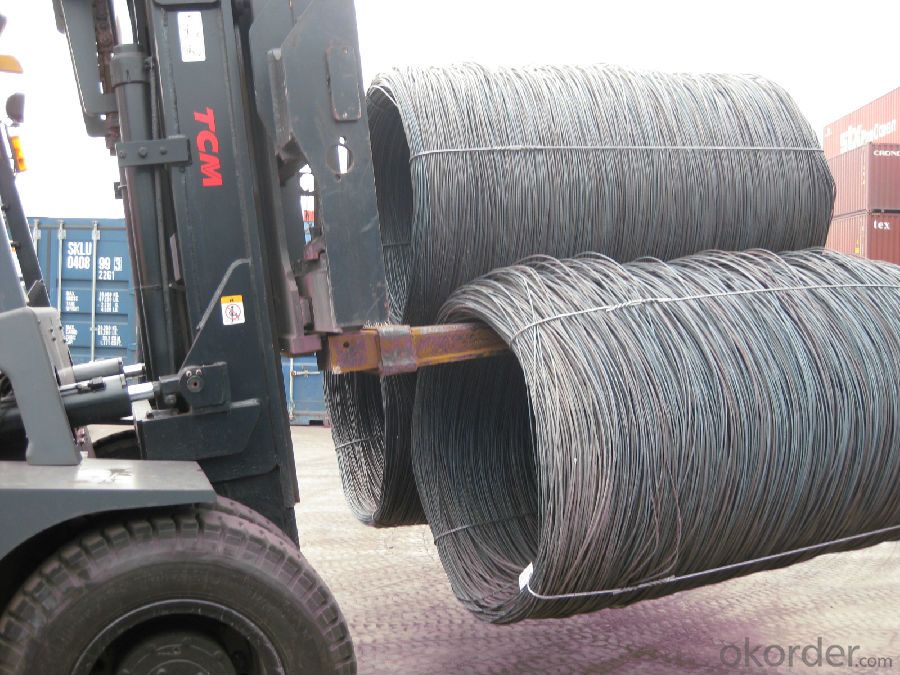
FAQ of SAE1006Cr Carbon Steel Wire Rod 8mm for Welding:
Q1: Why buy Materials & Equipment from OKorder.com?
A1: All products offered byOKorder.com are carefully selected from China's most reliable manufacturing enterprises. Through its ISO certifications, OKorder.com adheres to the highest standards and a commitment to supply chain safety and customer satisfaction.
Q2: How do we guarantee the quality of our products?
A2: We have established an advanced quality management system which conducts strict quality tests at every step, from raw materials to the final product. At the same time, we provide extensive follow-up service assurances as required.
Q3: How soon can we receive the product after purchase?
A3: Within three days of placing an order, we will begin production. The specific shipping date is dependent upon international and government factors, but is typically 7 to 10 workdays.
Q4: What makes stainless steel stainless?
A4: Stainless steel must contain at least 10.5 % chromium. It is this element that reacts with the oxygen in the air to form a complex chrome-oxide surface layer that is invisible but strong enough to prevent further oxygen from "staining" (rusting) the surface. Higher levels of chromium and the addition of other alloying elements such as nickel and molybdenum enhance this surface layer and improve the corrosion resistance of the stainless material.
Q5: Can stainless steel rust?
A5: Stainless does not "rust" as you think of regular steel rusting with a red oxide on the surface that flakes off. If you see red rust it is probably due to some iron particles that have contaminated the surface of the stainless steel and it is these iron particles that are rusting. Look at the source of the rusting and see if you can remove it from the surface.
- Q: How is steel wire rod used in the manufacturing of wire for aerospace applications?
- The manufacturing of wire for aerospace applications heavily relies on steel wire rod. This component is crucial and serves as the primary raw material for producing high-quality wires that meet the demanding requirements of the aerospace industry. To enhance the mechanical properties and ensure purity, the steel wire rod undergoes a series of processes like cleaning, descaling, and heat treatment. These processes effectively remove any impurities or contaminants that could negatively affect the wire's performance or structural integrity. Once the steel wire rod is prepared, it is drawn through a series of dies multiple times to decrease its diameter and increase its length. This drawing process is carefully monitored to maintain dimensional accuracy and consistent quality, ultimately achieving the desired wire thickness and strength. Following the drawing process, the wire undergoes additional treatments such as annealing or stress relieving to improve its ductility and resistance to fatigue. These treatments are crucial for aerospace applications, as the wire will experience extreme forces and temperature variations. The manufactured wire then undergoes rigorous testing and quality control measures to ensure it meets the stringent standards set by the aerospace industry. These tests involve examining the wire's mechanical properties, surface finish, and dimensional accuracy. Once the wire successfully passes all the necessary tests, it is ready for use in various aerospace applications. Wire manufactured from steel wire rod is commonly employed in aircraft control cables, wiring harnesses, fasteners, springs, and other critical components. Its high strength, durability, and corrosion resistance make it well-suited for withstanding the demanding conditions of aerospace environments. In conclusion, steel wire rod is a crucial component in the manufacturing of wire for aerospace applications. It undergoes various processes, drawing, and treatments to enhance its properties and achieve the desired wire dimensions and strength. Thorough testing ensures that the resulting wire meets aerospace standards. Ultimately, this wire plays a significant role in critical aerospace components, contributing to the safety and performance of aerospace systems.
- Q: What are the common production processes for actinium-coated steel wire rod?
- The common production processes for actinium-coated steel wire rod typically involve several steps. First, the steel wire rod is cleaned and prepared to ensure its surface is free from any impurities. Then, a layer of actinium is deposited onto the surface of the wire rod using a variety of methods such as electrodeposition or physical vapor deposition. Once the actinium coating is applied, the wire rod may undergo further treatments such as heat treatment or mechanical polishing to enhance its properties. Finally, the coated wire rod is inspected for quality control and can be used in various applications such as nuclear reactors or research laboratories.
- Q: What are the main distribution channels for steel wire rod?
- The main distribution channels for steel wire rod include manufacturers, wholesalers, retailers, and e-commerce platforms. Manufacturers play a crucial role as they produce steel wire rod in various grades and sizes. They have their distribution networks to directly supply the product to wholesalers or retailers. These manufacturers often have their sales teams or agents who actively promote and sell their products to potential customers. Wholesalers are intermediaries who purchase large quantities of steel wire rod from manufacturers and then distribute it to retailers or other businesses. They typically have extensive networks and warehouses to store and transport the product efficiently. Wholesalers often offer competitive pricing and bulk discounts, making them an attractive option for retailers and businesses looking to buy steel wire rod in large quantities. Retailers are the final link in the distribution chain, selling steel wire rod directly to end consumers or small businesses. They can be specialized steel suppliers or hardware stores that carry a wide range of products. Retailers often provide convenient access to steel wire rod for customers who require smaller quantities or immediate availability. In recent years, the emergence of e-commerce platforms has significantly impacted the distribution of steel wire rod. Online marketplaces allow manufacturers, wholesalers, and retailers to reach a wider customer base and facilitate direct sales. E-commerce platforms provide convenience, quick delivery, and often offer competitive pricing, making it an increasingly popular choice for buyers. Overall, the main distribution channels for steel wire rod encompass a combination of traditional channels such as manufacturers, wholesalers, and retailers, as well as the growing prominence of e-commerce platforms in the industry.
- Q: How is steel wire rod used in the production of wire mesh conveyor belts?
- Steel wire rod is an essential component in the production of wire mesh conveyor belts. These belts are commonly used in industries such as food processing, mining, and automotive manufacturing. The steel wire rod is first processed through a series of machines to form wires of the desired thickness and strength. Once the wires are formed, they are woven together to create a mesh pattern. The steel wire rod provides the necessary strength and durability to withstand heavy loads and high temperatures typically encountered in conveyor belt applications. Additionally, the steel wire rod's flexibility allows the mesh to be easily bent and shaped to fit various conveyor belt configurations. The wire mesh conveyor belts offer several advantages over traditional conveyor belts made from other materials. The open mesh design allows for better airflow and drainage, making them ideal for applications that involve heat or liquids. They also provide excellent strength-to-weight ratio, ensuring long-lasting performance and reducing maintenance costs. Moreover, the steel wire rod used in wire mesh conveyor belts can be coated with materials such as PVC or galvanized to enhance its corrosion resistance. This further extends the lifespan of the conveyor belt, making it suitable for use in harsh environments or industries where corrosive substances are present. In summary, steel wire rod is a crucial component in the production of wire mesh conveyor belts. Its strength, durability, and flexibility make it ideal for withstanding heavy loads, high temperatures, and corrosive environments. These belts offer several advantages over traditional conveyor belts, making them a popular choice in various industries.
- Q: What are the different tensile testing methods for steel wire rod?
- There are several different tensile testing methods that can be used to evaluate the mechanical properties of steel wire rods. These methods are designed to measure the strength, ductility, and other important characteristics of the material. Some of the most commonly used tensile testing methods for steel wire rods include: 1. Standard Tensile Test: This is the most basic method of tensile testing, where a sample of the steel wire rod is subjected to an increasing tensile load until it fractures. The load and elongation are continuously measured, allowing for the calculation of properties such as ultimate tensile strength, yield strength, and elongation at fracture. 2. Charpy Impact Test: This method evaluates the impact toughness of the steel wire rod by measuring the energy absorbed during the fracture of a notched specimen. It involves striking the sample with a pendulum hammer and recording the energy absorbed as the hammer breaks the specimen. This test is particularly useful for determining the resistance of the material to sudden impact or shock loading. 3. Bend Test: In this method, a steel wire rod specimen is bent to a specific angle without fracturing. The bend test is used to assess the ductility and resistance to cracking of the material. The sample is typically bent around a mandrel of a specified diameter, and any signs of cracking or fracture are noted. 4. Hardness Test: Hardness testing is a non-destructive method used to determine the resistance of the steel wire rod to penetration or indentation. Various hardness testing methods are available, including Rockwell, Brinell, and Vickers tests. These tests involve applying a known load to the specimen surface and measuring the depth or size of the resulting indentation. Hardness values can be correlated to tensile strength, making it a useful technique for quality control purposes. 5. Fatigue Test: Fatigue testing is used to evaluate the endurance limit and fatigue life of the steel wire rod under repeated cyclic loading. The specimen is subjected to a varying load or stress amplitude over a specified number of cycles until failure occurs. This test helps determine the material's ability to withstand repetitive loading conditions over time. Overall, these different tensile testing methods provide valuable insights into the mechanical properties of steel wire rods, helping engineers and manufacturers ensure the material meets the required specifications for their intended applications.
- Q: What are the different international specifications for steel wire rod?
- Steel wire rod must meet specific requirements and characteristics outlined in various international specifications. Commonly used specifications include ASTM A510, EN 10016-2, JIS G 3505, GB/T 699, and ISO 16120-4. These standards cover carbon steel wire rods, non-alloy steel rods, low carbon steel wire rods, and general requirements for steel wire rod. Additionally, industry-specific standards and customer requirements may exist for specific applications. Consulting the relevant specifications is crucial to ensure compliance and meet application needs.
- Q: How is steel wire rod used in the manufacturing of automotive springs?
- Steel wire rod is commonly used in the manufacturing of automotive springs due to its high tensile strength and durability. It is first drawn into the desired thickness and then coiled to form the spring shape. The wire rod's strength allows the spring to withstand heavy loads and provide the necessary support and stability for the vehicle's suspension system. Additionally, its ability to resist deformation and maintain its shape over time ensures the longevity and reliability of the automotive springs.
- Q: What are the different types of defects that can occur in steel wire rod?
- There are several different types of defects that can occur in steel wire rods. These defects can arise during the manufacturing process or as a result of various external factors. Some common types of defects include surface defects, internal defects, and dimensional defects. Surface defects are often the most visible and can include scratches, pits, cracks, and scale. These defects can occur due to improper handling or storage of the wire rod, as well as issues during the rolling or finishing processes. Surface defects can affect the appearance and functionality of the wire rod and may require further processing or treatment to rectify. Internal defects are defects that occur within the structure of the wire rod and are not visible from the surface. These defects can include inclusions, voids, and segregations. Inclusions are foreign particles that have become trapped within the steel matrix during the manufacturing process. Voids are areas of missing material, while segregations refer to variations in the composition or structure of the steel. Internal defects can weaken the wire rod and reduce its mechanical properties, making it more prone to failure under stress or load. Dimensional defects refer to variations or deviations from the specified dimensions or tolerances of the wire rod. These defects can include variations in diameter, out-of-roundness, straightness, or surface finish. Dimensional defects can occur due to issues with the rolling process, improper cooling or heat treatment, or variations in the raw material used. These defects can affect the suitability and performance of the wire rod for its intended application. It is important to note that the occurrence of defects can be minimized through proper manufacturing practices, quality control measures, and adherence to industry standards and specifications. Regular inspection and testing of wire rods can help detect and address any defects, ensuring the production of high-quality and reliable steel wire rods.
- Q: How are steel wire rods used in the production of welding electrodes?
- Steel wire rods are essential components in the production of welding electrodes. These wire rods serve as the core material for welding electrodes, providing the necessary strength and conductivity required for the welding process. To begin the production of welding electrodes, steel wire rods are first selected based on their specific mechanical properties, such as tensile strength and elongation. These properties ensure that the welding electrodes will be able to withstand the high temperatures and stress experienced during the welding process. The steel wire rods are then further processed through a series of steps. They are first cleaned and coated with a flux material, which helps to remove impurities and promote better arc stability during welding. This coating also assists in the formation of a protective gas shield around the welding area, preventing oxidation and contamination. After the coating process, the steel wire rods are cut into specific lengths and shaped into the desired electrode design. This can involve bending or forming the rods to achieve the required shape and size of the welding electrode. Once the welding electrode is formed, it is then packaged and made ready for distribution and use. These electrodes are widely used in various industries, including construction, automotive, and manufacturing, for welding applications such as joining metals, repairing machinery, and fabricating structures. In summary, steel wire rods play a crucial role in the production of welding electrodes. They provide the necessary strength, conductivity, and formability required for these electrodes to effectively carry out welding processes.
- Q: How are steel wire rods used in the production of wire ropes for cranes?
- Wire ropes for cranes heavily rely on steel wire rods, which act as a crucial ingredient. These rods function as the primary material in the wire rope manufacturing process. Initially, careful selection of steel wire rods is based on their mechanical properties, such as strength and durability. Subsequently, a sequence of processes, including cleaning, heating, and drawing, is applied to transform the rods into wire strands. After the formation of wire strands, they are tightly wound together to create the wire rope. This procedure entails intertwining numerous strands around a central core, typically composed of fiber or steel. The arrangement of the wire strands in a helical pattern enhances both the strength and flexibility of the wire rope. The steel wire rods specifically chosen for the production of wire ropes for cranes possess high tensile strength. This ensures that the wire ropes can endure heavy loads and extreme working conditions. The strength of the steel wire rods directly impacts the overall strength and safety of the wire ropes. Moreover, during the manufacturing process, the steel wire rods undergo various quality control measures to ensure their dependability and consistency. These measures entail testing for tensile strength, breaking load, and other performance parameters. Once the wire ropes are manufactured using the steel wire rods, they find utility in a wide range of crane applications. Wire ropes are indispensable for lifting and transporting heavy loads, providing stability and control throughout crane operations. They play a critical role in the secure and efficient lifting, lowering, and suspension of loads in diverse construction, industrial, and maritime settings. In conclusion, steel wire rods are an essential part of wire rope production for cranes, as they deliver the necessary strength, durability, and reliability required in demanding work environments.
Send your message to us
SAE1006Cr Carbon Steel Wire Rod 8mm for Welding
- Loading Port:
- Shanghai
- Payment Terms:
- TT OR LC
- Min Order Qty:
- 100 m.t
- Supply Capability:
- 30000 m.t/month
OKorder Service Pledge
OKorder Financial Service
Similar products
Hot products
Hot Searches
Related keywords
